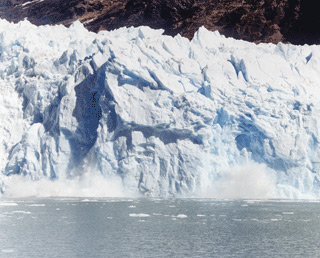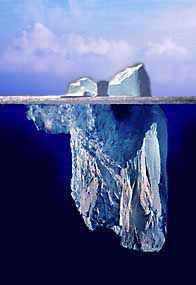
Icebergs
Not only are glaciers responsible for spectacular landscape features on the ground, but they also create icebergs in the seas. An iceberg that had been broken off of a glacier was responsible for the sinking of the Titanic. The process of an iceberg breaking off of a glacier is called calving.
Calving occurs because glacial ice tends to spread out at the terminus of a glacier. It is usually preceded by a loud booming sound as the ice begins to break apart. When the ice falls into the sea, it can cause a hazardous vibration of water for as far out as 2 miles. Each year, as many as 15,000 icebergs calve off of the Greenland Ice Sheet alone. Roll your pointer over the image on the right and observe the animation of calving.

Typically only about one-tenth of an iceberg’s volume is above water—lending to the expression "only the tip of the iceberg." Why does so much of the iceberg (pictured left) remain below the water's surface?
The density of the freshwater that makes up an iceberg is about 920 kilograms per meter cubed (kg/m3), but the density of seawater is about 1025 kg/m3. The iceberg is about 90% as dense as seawater. Thus it will be about 90% submerged, with the remaining 10% above the water's surface.